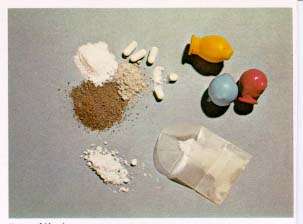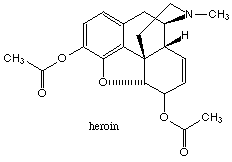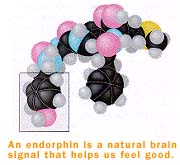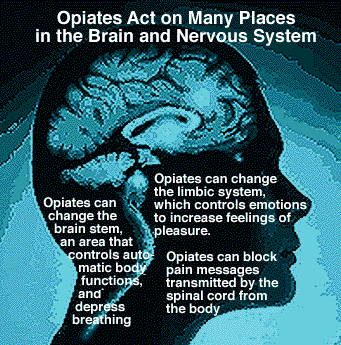Heroin

Heroin in Powder and Pill Forms with Balloons
What are opiates?
The most abused
form of opiates is heroin. Heroin is processed from morphine.
Heroin is typically sold as a white or brownish powder or as the black
sticky substance known as "Black Tar Heroin." Other opiates include
opium, codeine, morphine, hydromorphone (Dilaudid), methadone, and meperidine
(Demerol). Opiate-like drugs behave like inhibitory neurotransmitters,
as their effects are similar to the effects of GABA. Opiates are
part of the agonist family of drugs. An agonist is a chemical that
binds to a specific receptor and produces either excitation or inhibition
of action potentials. This family also includes cannabis, nicotine,
and hallucinogens such as LSD.

Statistics of Heroin Use in the
United States
-
1998 National Household Survey on Drug
Abuse
-
~2.4 million people had used heroin
at some time in their lives and nearly 130,000 of them reported using it
within the month preceeding the survey
-
81,000 new heroin users in 1997
-
A large proportion of these recent
new users were smoking, snorting, or sniffing heroin, and most were under
the age of 26(87%)
-
1998 Drug Abuse Warning Network
-
14% of all drug-related emergency department
episodes involved heroin
-
Between 1991 and 1996, heroin-related
emergency department episodes more than doubled
-
Among youths aged 12 to 17, heroin-related
episodes nearly quadrupled.
How is heroin used?
-
Injection- predominant method of heroin
consumption among addicted users seeking treatment
-
Sniffed/snorted
-
Smoked
How do opiates exert their effect on
the brain?
In the early
1970's, it was demonstrated that the brain contained opiate receptors.
These receptors not only recognize opiates, but also endogenous opioids,
such as endorphins, enkephalins, and dynorphins. It must be made
clear that these receptors were not designed specifically to recognize
the plant alkaloid, it just so happens that opiates have the same chemical
structure as the body's endogenous opioids. These opiate receptors either
slow down or inhibit the activity of the neurons that contain them.


As
was explored earlier, opiates work on the brains reward system to provide
pleasure. Opiates increase the activity of the dopamine-containing
neurons of the VTA. The dopamine containing
neurons of the VTA are under tight control. These neurons receive
both inhibitory and excitatory signals and the sum of these signals determines
whether or not the neuron will fire and the rate at which the neuron fires.
Another group of neurons regulates the neurons of the VTA by producing
the neurotransmitter gamma-aminobutyric acid (GABA). When these regulatory
neurons are active, they inhibit dopamine neurons causing a reduced release
of dopamine. These GABA receptors contain opiate receptors.
When opiates bind to these receptors, they prevent the GABA neurons send
fewer inhibitory signals to the dopamine neurons. The dopamine neurons
then are free to release more dopamine from their axon terminals in the
nucleus accumbens. In addition, the neurons of the nucleus accumbens
that are across from the synapse from the axon terminals of the dopamine-releasing
neurons also contain opiate receptors. As a result opiates can act
directly on the nucleus accumbens and can thus produce reward.

Short Term Effects of Heroin Use
-
A feeling of a "rush" - intensity if
a function of how much drug is taken and how rapidly the drug enters the
brain and binds to the natural opiod receptor.
-
Accompanying the rush are warm flushing
of the skin, dry mouth, and a heavy feeling in the extremities, nausea,
vomiting, and severe itching
-
Drowsiness
-
Slowing of cardiac function and breathing
-
Clouded mental state
-
Suppression of pain
-
Spontaneous abortion
Long Term Effects of Heroin Use
-
Addiction
-
Infectious diseases, for example HIV/AIDS
and Hepatitis B and C
-
Collapsed veins
-
Bacterial infections
-
Abscesses
-
Infection of the lining and heart valves
Medical Complications of Chronic Heroin
Use
-
Scarred and/or collapsed veins
-
Bacterial infections of the blood vessels
and heart valves
-
Abscesses (boils) and other soft-tissue
infections
-
Liver or kidney disease
-
Lung complications resulting from the
overall poor health of the abuser
-
Clogging in the blood vessels.
-
Arthritis or other rhematologic problems.
-
Hepatitis B and C
-
HIV
-
Other blood borne pathogens
Main,
Definition,
Development,
Pathology,
Psychology,
Sociology,
Treatment





